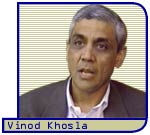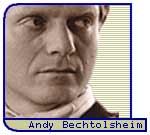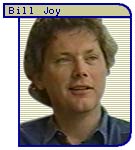 |
|||
 |
|||
While growing up in India,
Vinod Khosla, dreamed of
starting his own high-tech company and becoming rich like the founders
of Hewlett-Packard and Intel.
He still wanted to start his own company, and in 1982
he found a product he knew he could sell, a workstation. A graduate
student named
Andy Bechtolsheim studying
computer science at Stanford
had already built a name for himself on campus because of the workstation
he designed. A workstation is a computer more powerful than a personal
computer but small enough to sit on a desktop. It had built-in networking,
because Bechtolsheim knew researchers needed it, and it used the Unix
operating system, a nonproprietary operating system developed at Bell
Laboratories. Bechtolsheim designed the workstation to fill a void
in the computer science department. He was frustrated with the aging
time-sharing system used at Stanford, and he thought everyone could
get a lot more work done if they had immediate access to a computer
and still be able to exchange data.
However, Kolshod told him "I don't want to do that.
I want the goose that lays the golden egg. I don't want the golden
egg." He wanted Bechtolsheim to join a partnership with him to build
the workstations for sale. It was difficult to convince Bechtolsheim
because he wanted to stay at Stanford and complete his Ph.D. work,
but he eventually agreed. To help with the business side, Kolshod recruited
a fellow Stanford Business School graduate,
Scott McNealy. McNealy
had no experience starting a company, but he was excited about the
prospect. Now they had two business people and a hardware expert. All
they needed was a software expert to cover all facets of the product.
The choice was easy,
Bill Joy.
Khosla found more venture capital for his new company
(initially called "VLSI Systems") from
John Doerr of Kleiner, Perkins,
Caufield and Byers (silicon valley venture capitalists). Doerr had
known the initial trio from Stanford, and he understood how big a Unix
workstation would be in the research and business market. With a few million dollars in the bank, a prototype
motherboard, and a networking operating system, the company began building
their workstations under the new name of
Sun (in homage to the Stanford
University Network). By 1988, they passed $1 billion in sales and were
the second fastest growing computer company in history. It was a success
story rarely matched since. ![]() Sun Rises
Sun Rises
 When he came
to this country
to study business at Stanford Business School, he got a chance to help
draft a business plan for a technology company named Daisy Systems.
The business succeeded, and Khosla cashed-in and walked away rich at
the age of 27.
When he came
to this country
to study business at Stanford Business School, he got a chance to help
draft a business plan for a technology company named Daisy Systems.
The business succeeded, and Khosla cashed-in and walked away rich at
the age of 27.  His idea was to license
the new technology to companies that could build it and then get the
computers from them. He had already licensed the workstation idea to
over seven companies before Kolshod approached him, so he thought Kolshod
just wanted another license.
His idea was to license
the new technology to companies that could build it and then get the
computers from them. He had already licensed the workstation idea to
over seven companies before Kolshod approached him, so he thought Kolshod
just wanted another license.  Bill Joy was a young computer science professor across the bay at Berkeley.
Joy had quickly gained the reputation as one of the best computer scientists
in the country at the age of 27, the same age as the other three. Having
worked on implementing parts of the ARPAnet, Joy had plenty of networking
experience. He had also rewritten the
Unix operating system to incorporate
TCP/IP and released it as Berkeley Unix (BSD).
Bill Joy was a young computer science professor across the bay at Berkeley.
Joy had quickly gained the reputation as one of the best computer scientists
in the country at the age of 27, the same age as the other three. Having
worked on implementing parts of the ARPAnet, Joy had plenty of networking
experience. He had also rewritten the
Unix operating system to incorporate
TCP/IP and released it as Berkeley Unix (BSD).
Copyright © 1998, PBS Online,
Inc. All Rights Reserved.
Site Designed and Developed by
OPB Learning Media